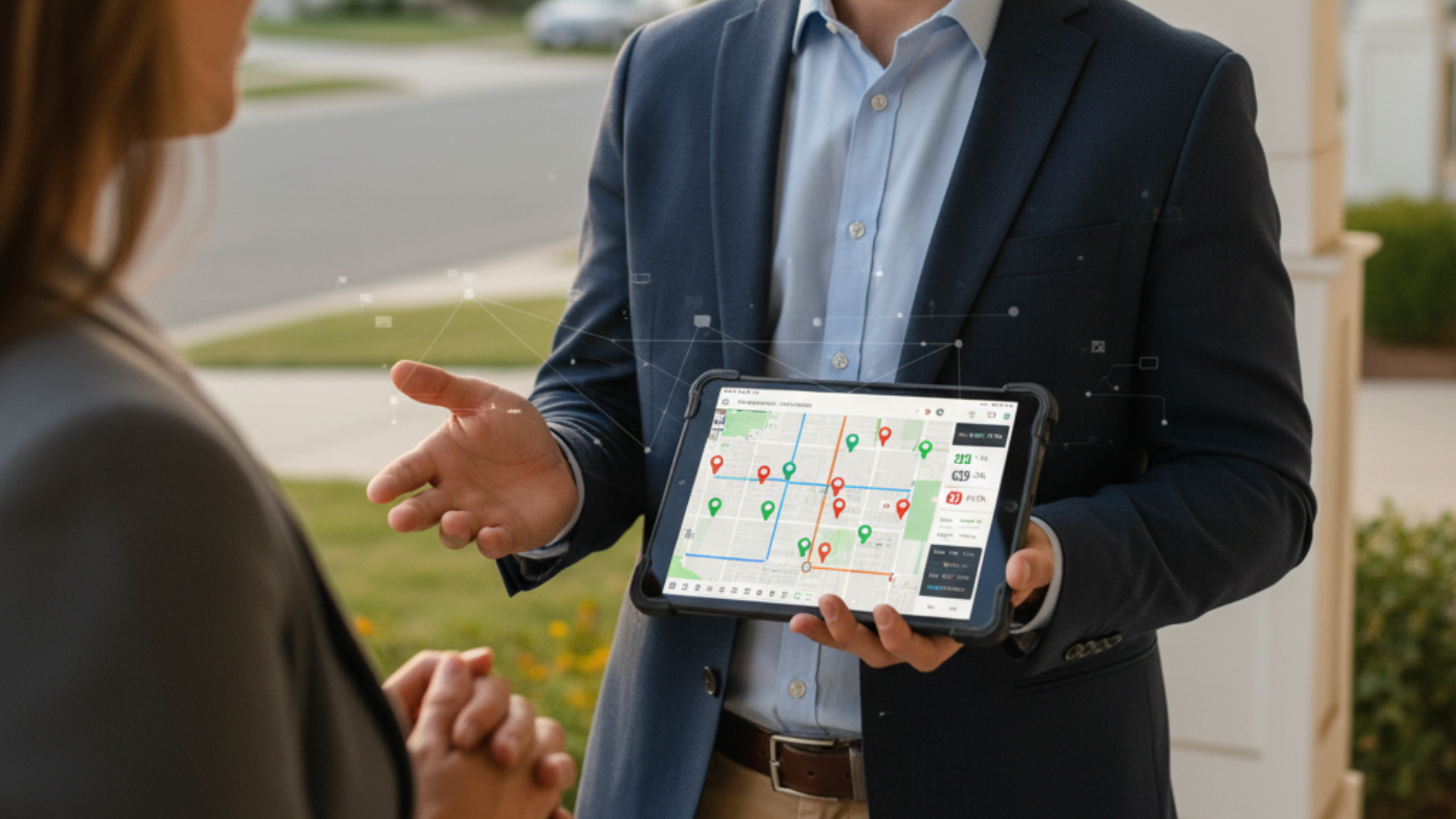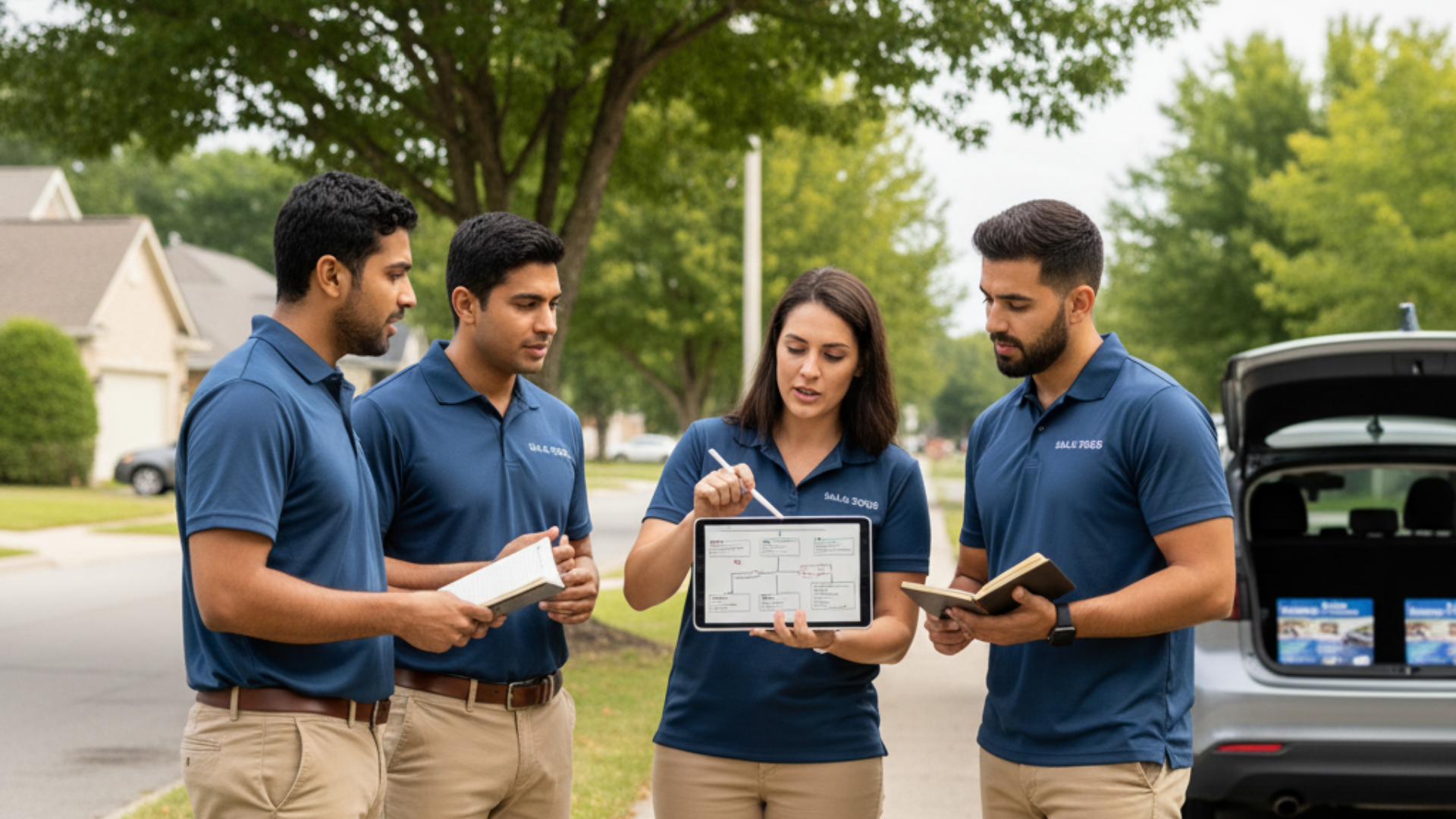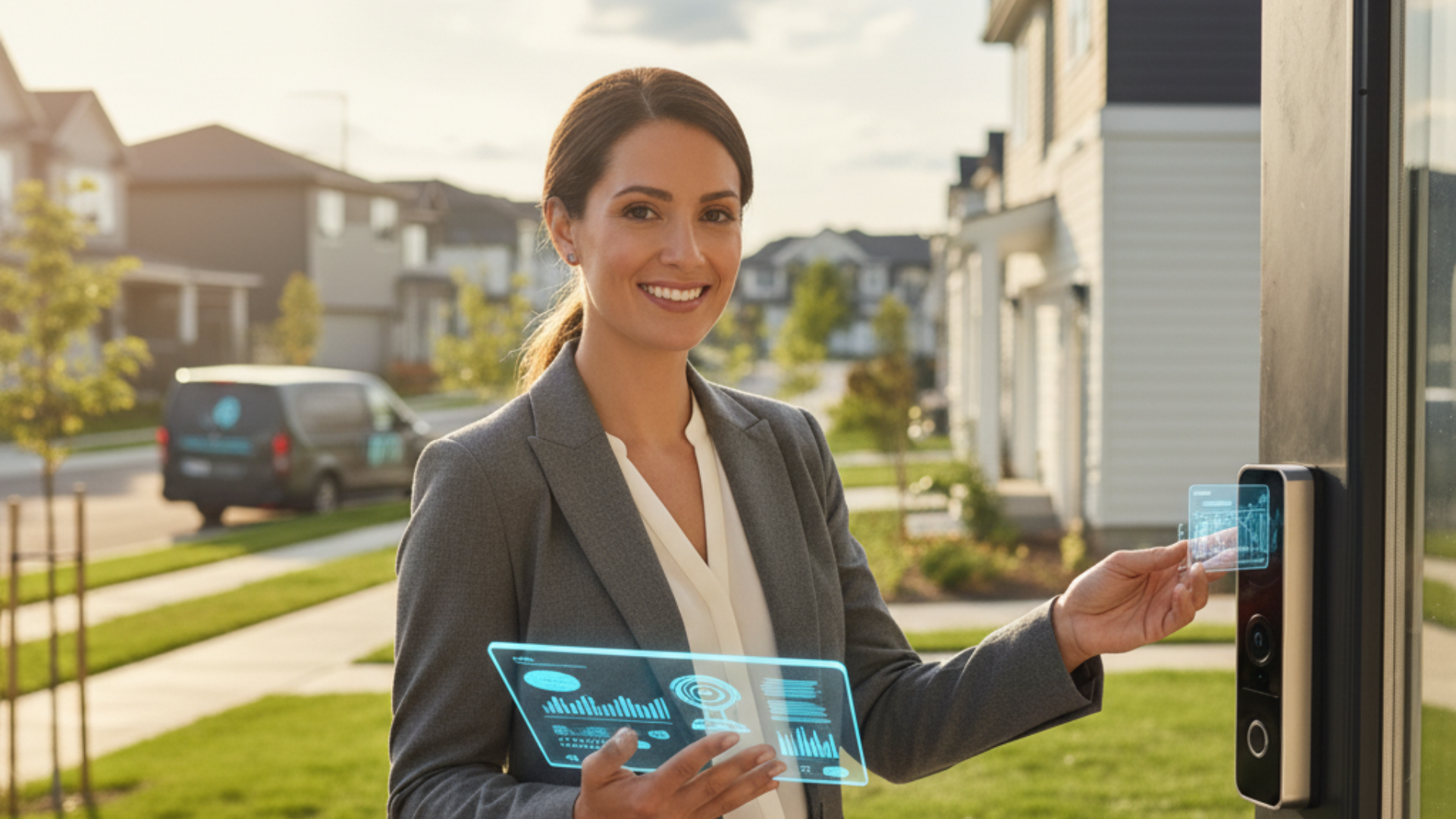Knocking on doors is one of the oldest and most effective ways to generate leads, but it can feel challenging if you do not know what to say.
The truth is, having a clear and simple script makes the process much easier. It helps you start conversations, handle rejections, and build trust without sounding like a robot.
Whether you are new to door-to-door sales or looking to sharpen your skills, these proven scripts will give you the confidence to approach any homeowner.
They are designed to grab attention quickly with a captivating opening line, spark interest, and keep the conversation moving toward a clear goal.
The best part is that you can tailor them to fit your personality and the product or service you are selling, making you sound natural and approachable.
Proven Door-Knocking Scripts That D2D Teams Swear By
Picture this: You’ve just finished a long day, and suddenly there’s a knock at your door. Someone’s standing there, smiling, ready with a pitch.
Most of us instinctively tense up. This is simply because too many sales reps rely on the same pitch that feels scripted, generic, and disconnected, failing to establish common ground.
But here’s the thing, door-to-door sales isn’t dead, it's far from it. In 2025, it’s alive, thriving, and still one of the most effective ways to connect with potential customers face-to-face.
What’s changed is how it’s done. Today’s successful door-to-door script isn’t about bulldozing through objections or rattling off product features.
It’s about building rapport immediately, listening carefully to the prospect's pain points, and ensuring your sales pitch feels more like a conversation than a performance.
In this guide, you’ll learn why door-to-door selling still wins, what makes a successful sales script, and how you can use proven frameworks to achieve success in the field.
Key Takeaways
- A good door-knocking script gives you structure and confidence, making conversations with homeowners feel natural instead of forced.
- The most effective scripts are simple, attention-grabbing, and focused on solving a problem for the homeowner.
- Practicing scripts regularly helps D2D reps overcome rejection and stay consistent in their pitch.
- Personalization is key. Scripts work best when adapted to your style, tone, and product.
- Proven scripts save time, boost appointments, and help sales teams close more deals at the door.
Why Door-to-Door Scripts Still Work in 2025
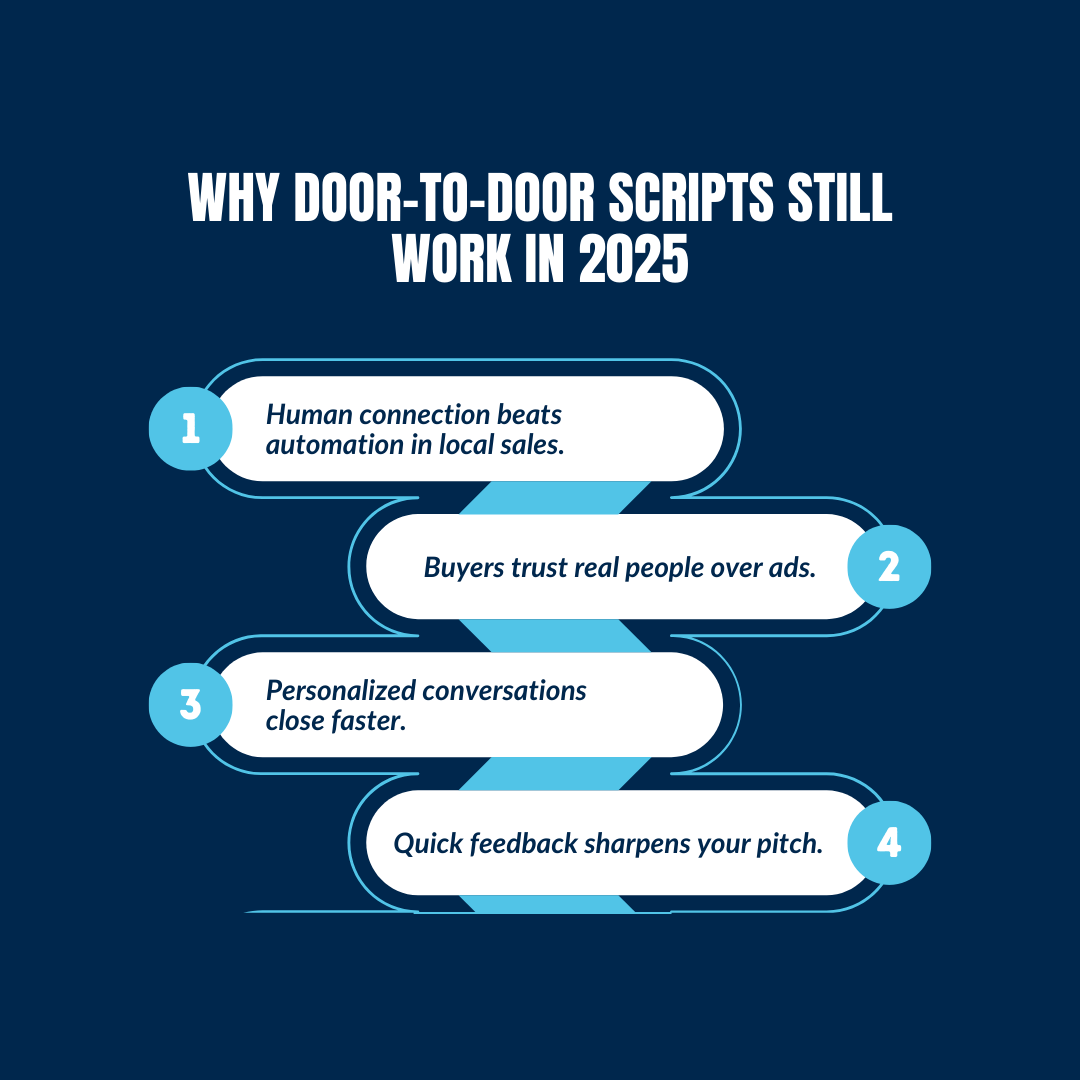
The sales industry has changed. Automation tools, digital ads, and AI-driven campaigns flood people’s feeds. Yet, door-to-door sales still deliver results, which is crucial for ensuring customer satisfaction. Why?
- Human connection beats automation in local sales: People are overwhelmed by ads online, but a genuine face-to-face conversation through proven door-knocking scripts feels more personal and trustworthy.
- Buyers trust real people over ads: A polished D2D sales pitch at the doorstep carries more weight than a pop-up banner because it shows effort, care, and human credibility.
- Personalized conversations close faster: With the right door-to-door script, you can instantly adjust your pitch to the homeowner’s needs, making the conversation more relevant and closing the sale faster.
- Quick feedback sharpens your pitch: In door-knocking sales, you get an immediate reaction to your opener, letting you refine your script the same day instead of waiting weeks like with digital ads.
For example, a solar rep can use a clear door-to-door pitch to show a homeowner exactly how much they could save on monthly utility bills with panels. That instant, real-world benefit related to energy efficiency is something no online campaign can compete with.
The Psychology Behind a Winning Door-to-Door Script
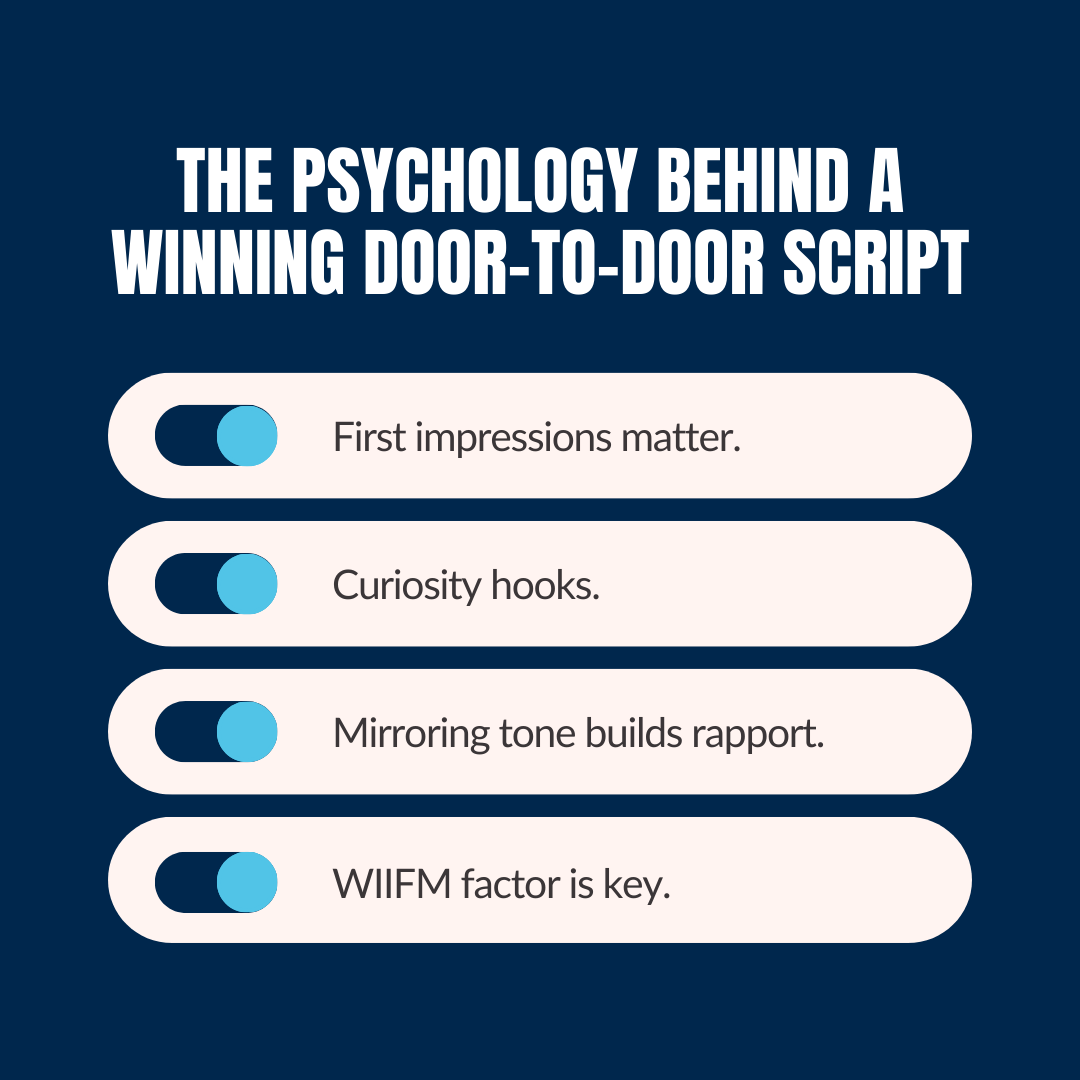
A winning door-to-door script often comes down to psychology. Even the best door-to-door script won’t work if the delivery feels off. Here’s what makes the difference:
- First impressions matter: In D2D sales, homeowners size you up within seconds. A confident smile, steady eye contact, and a calm tone instantly make your door-to-door pitch more credible.
- Curiosity hooks: A proven door-knocking script starts with a question that sparks interest instead of sounding like a sales pitch. Saying, “Have you noticed your energy bills climbing lately?” draws people in faster than “I’m here to sell solar.”
- Mirroring tone builds rapport: The best door-to-door pitches adapt to the homeowner’s vibe. If they’re quiet and cautious, keep things steady. If they’re upbeat, match their energy to make the conversation flow naturally.
- WIIFM factor is key: Every prospect is thinking, “What’s in it for me?” A strong D2D script answers that right away, showing clear benefits like saving money or making life easier.
At the end of the day, the script is just the framework; it’s your delivery, tone, and empathy that turn a door-to-door pitch into a real connection.
The First 10 Seconds: Make-or-Break Openers
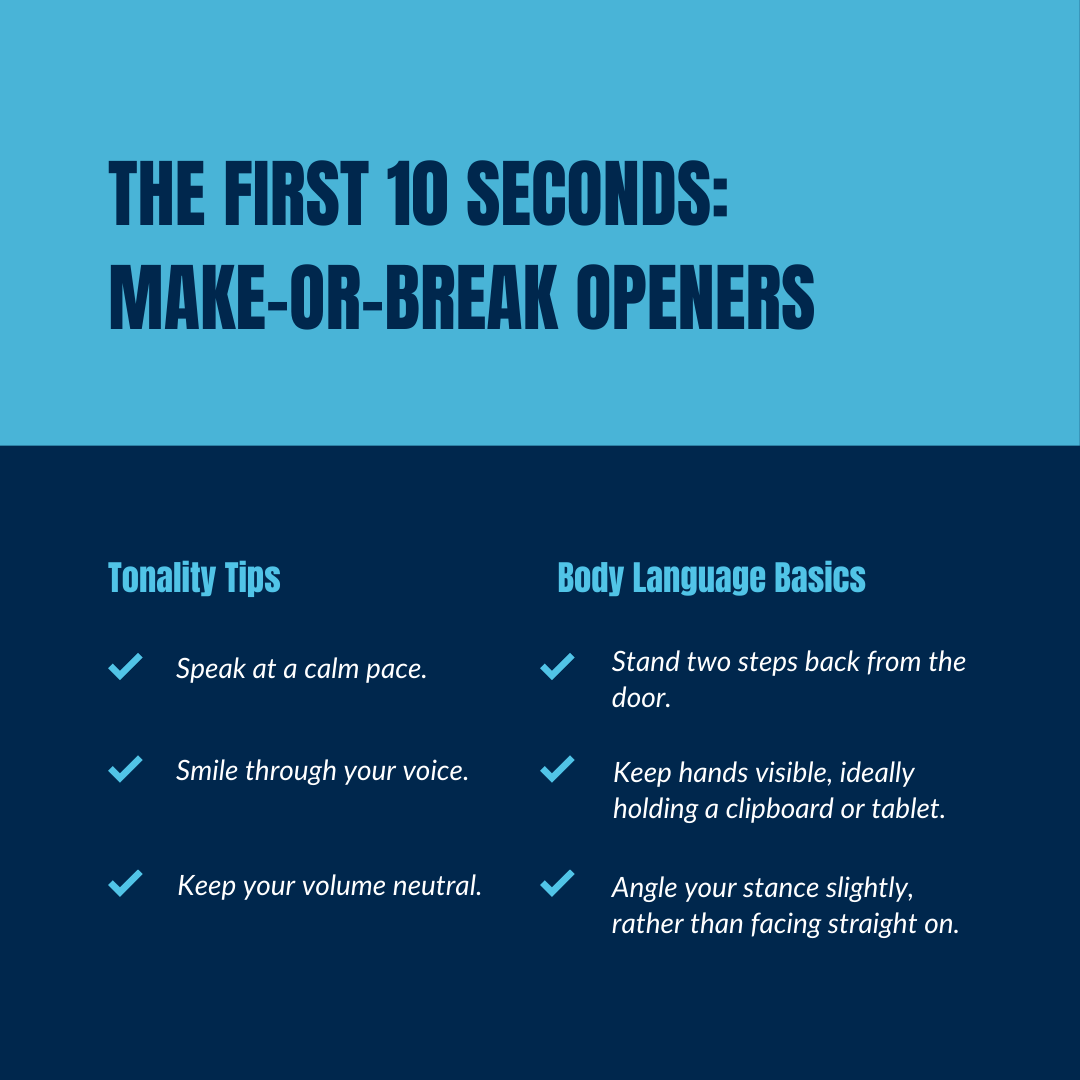
In door-to-door sales, the opener is everything. You have a few seconds to show you’re safe, professional, and relevant with an effective door opener.
Tone Guidelines
- Speak at a calm pace- Rushing makes your door-to-door pitch sound pushy. A steady pace shows confidence and puts the homeowner at ease.
- Smile through your voice- Even if they can’t see it right away, a friendly tone makes your door-knocking script feel warm and trustworthy.
- Keep your volume neutral- Too loud feels intrusive, too soft feels uncertain. A balanced tone keeps your D2D sales pitch approachable.
Body Language Basics
- Stand two steps back from the door- This gives space and shows respect, making your door-to-door pitch less intrusive.
- Keep hands visible, ideally holding a clipboard or tablet- It signals professionalism and reassures the homeowner that you’re there with a purpose.
- Angle your stance slightly, rather than facing straight on- This makes your approach feel relaxed and non-threatening, which helps the door-to-door script land better.
Remember, the goal of your opening line isn’t to close the deal; it’s to earn just a few minutes of attention so you can deliver real value with your door-to-door script to sales professionals.
High-Converting Door-to-Door Script Templates: Short, Field-Tested, and Easy to Customize
Here’s where we get practical. Below are ten scripts that top-performing sales teams use every day.
Script 1: Neighborhood Cred Opener
When to use: New territory, storm follow-ups, clusters of current customers.
Script:
“Hey, I’m [Name] with [Company]. We’re helping a few neighbors on [Street] with [benefit/outcome]. Quick question, who handles [service] for your place?”
Follow-up:
“Got it. If we could [benefit in a quick check], would you want a look?”
Script 2: Social Proof Referral
When to use: Near active jobs, warm revisits.
Script:
“We just finished at [Neighbor/Street]. They mentioned [common issue]. If you want, can I take a quick look at yours while I’m here?”
Script 3: Problem-First Hook
When to use: Clear pain signals like pests, leaks, or high energy bills.
Script:
“Most homes here see [problem] after [event]. Have you noticed that too?”
Script 4: Time-Window Offer
When to use: Limited crew availability.
Script:
“We’re in the area until [day/time] doing free [inspection/quote]. Today or tomorrow better for you?”
Script 5: 20-Second Value Stack
When to use: Busy or skeptical prospects.
Script:
“I’ll keep this brief: we check [X], [explain options, and give a written estimate]. It’s free. If it’s not the right fit, no problem at all."
Script 6: Safety + Transparency Intro
When to use: Cautious neighborhoods.
Script:
“Hi, I’ll keep my distance. I’m [Name], ID here. We’re licensed and local, helping on [Street]. Want me to text you two time options instead?”
Script 7: Inspection-to-Appointment Bridge
When to use: When interest is detected.
Script:
“Sounds like it’s worth a look. I can do a 10-minute check now, or we can schedule a time that works best for you. Which would you prefer?"
Script 8: Warm Return Visit
When to use: Follow-ups.
Script:
“Hey, it’s [Name]. Last time you mentioned [issue]. I can show you what it would take to fix it and the costs involved today. Would you like me to go over the numbers?"
Script 9: Gatekeeper-Friendly Script
When to use: When the spouse/tenant answers.
Script:
“Totally understand. What’s the best time for the [decision-makers] around? I can stop by briefly and leave a clear, written estimate."
Script 10: Commercial/PM Pitch
When to use: Property managers or HOAs.
Script:
“We help properties reduce [cost/risk] with [service]. If I map a plan with pricing this week, can we review it in 10 minutes on Friday?”
Need more help in building a great team? Have a look at this: How to build a Winning Door-to-Door Sales Team.
Objection-Handling Lines That Convert
In door-to-door sales, objections are normal, whether it’s “not interested,” “no time,” or “we already have a company.”
The goal isn’t to avoid them, but to handle them with confidence and empathy, using simple scripts that highlight your unique selling points, reframe the conversation, and maintain trust.
1. “Not interested.”
That’s totally fair; most homeowners say the same at first. But once they see how quick and simple the numbers are, the D2D pitch feels less like a hassle. How about I leave a summary and a time slot for you to review?
2. “No time.”
I get it, everyone’s busy. That’s why these door-to-door sales scripts are built to be quick. You can simply say: "Would 10 minutes later today or tomorrow work if I keep it tight?"
3. “We already have a company.”
Makes complete sense. Many of the clients we help already had someone else, but our pitch usually wins on speed or clarity. Say: "If I could provide you with a no-cost comparison, would you like a quick look?"
4. “Too expensive.”
I hear you; that’s why our script shows three options: standard, upgrade, and save now. This way, you decide what fits. Say: "Would you like me to show you the side-by-side comparison?"
5. “Send info.”
Script: I can definitely send it, but honestly, a 10-minute chat saves the back-and-forth. If you’d still rather have the email after, I’ll send it your way. Would today or tomorrow be easier?
How to Deliver Your Script Like a Pro
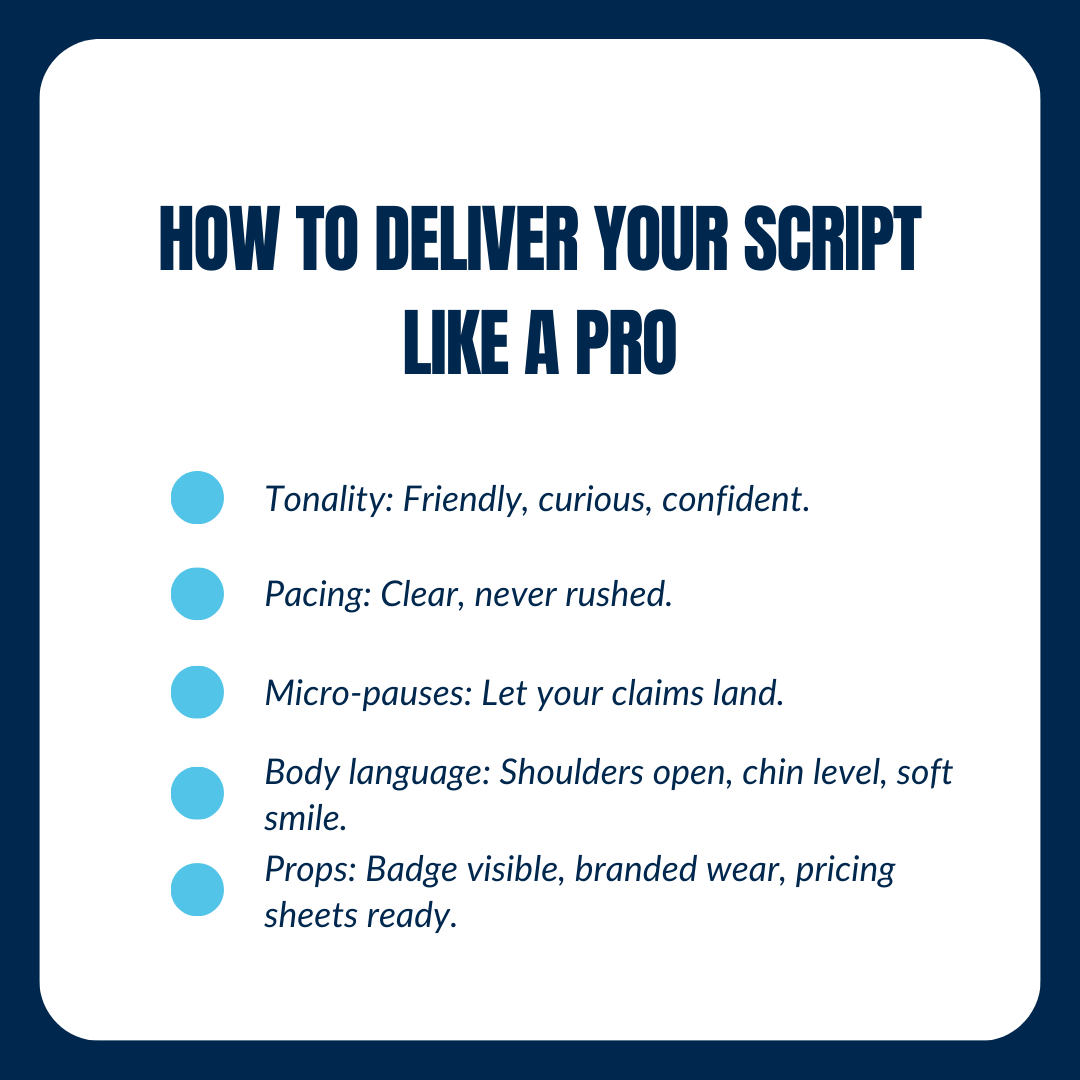
It’s not just words. It’s how you say them.
1. Tone: Friendly, curious, confident.
Your voice sets the mood, so keep it warm and confident; it shows you’re professional and makes homeowners feel comfortable right away.
2. Pacing: Clear, never rushed.
Speak at a steady pace that’s easy to follow; rushing makes you sound nervous, while clear pacing shows you respect their time.
3. Micro-pauses: Let your claims land.
Short pauses after key points give your words more weight and make prospects actually process what you’re saying.
4. Body language: Shoulders open, chin level, soft smile.
An open posture and a natural smile build trust quickly and make your pitch feel less like a “sales script” and more like a genuine conversation.
5. Props: Badge visible, branded wear, pricing sheets ready.
Having your badge, company logo, and simple visuals readily available instantly adds credibility and helps you appear professional.
The best salespeople make the same pitch sound different each time, adjusting based on the prospect’s interest.
The global door-to-door sales market is valued at approximately $208.5 billion in 2025, with expectations to reach $269 billion by 2029, growing at a 6.6% CAGR.
Cadence: Multi-Touch Door Strategy
- Touch 1: Quick intro + value + time choice
Your first knock should be light and respectful. Introduce yourself, share a clear benefit, and offer an easy time choice. This keeps it casual and shows you value their time right from the start. - Touch 2: Demo/photo proof + mini case study
On the second touch, bring something visual, such as a photo, a quick demo, or even a neighbor’s success story. Proof builds trust fast and helps homeowners see the value in just a few minutes. - Touch 3: Urgency window + lock appointment
By the third touch, your goal is to create a sense of urgency. Maybe it’s a limited-time inspection slot or a seasonal savings window. Give them a reason to act now and secure an appointment. - Follow-up: “Two slots just opened for [day/time]. Want one?”
A friendly follow-up message keeps the momentum alive. Short, simple lines like this make it easy for them to say yes without overthinking.
Closing Playbook: Micro-Closes, Next Steps, and Confident Delivery
Great closers don’t ask “yes or no” questions. They give easy choices.
- Time choice close: “Today or tomorrow?” “Morning or afternoon?”
Instead of pushing for a hard yes, give homeowners simple options. This way it feels lighter and keeps the decision easy to make. - Soft assumptive: “I’ll block 10 minutes at 4:30 unless another time works better for you.”
This approach assumes interest without being pushy and shows confidence while still giving them control. - Exit with momentum: “Here’s my card. Text YES and I’ll confirm the slot.”
Always leave the door open with a clear next step, so even if they hesitate now, the follow-up feels effortless.
Great closers in door-to-door sales focus on micro-closes and next steps, making the process smooth and pressure-free while still guiding the pitch forward.
Industry-Specific Script Variations
Solar Panels
“Energy bills are climbing fast, and most homeowners don’t realize how much they could save. If I can show you how to cut costs and lock in stable rates, wouldn’t a quick look be worth it?”
Roofing
“After a storm, small roof issues can turn into big problems. We’re already documenting storm impacts for your neighbors, and it only takes 10 minutes with photos. Do you want me to check yours, too?”
HVAC
“Older systems quietly drain money every month. If I can lay out repair vs. replace pricing in a simple 10-minute visit, would that give you clarity?”
Construction
“Most projects get delayed because scope and budget aren’t clear from the start. If I can map out a timeline, scope, and budget, would that help you plan better?”
What are the best practices for managing territory and timing
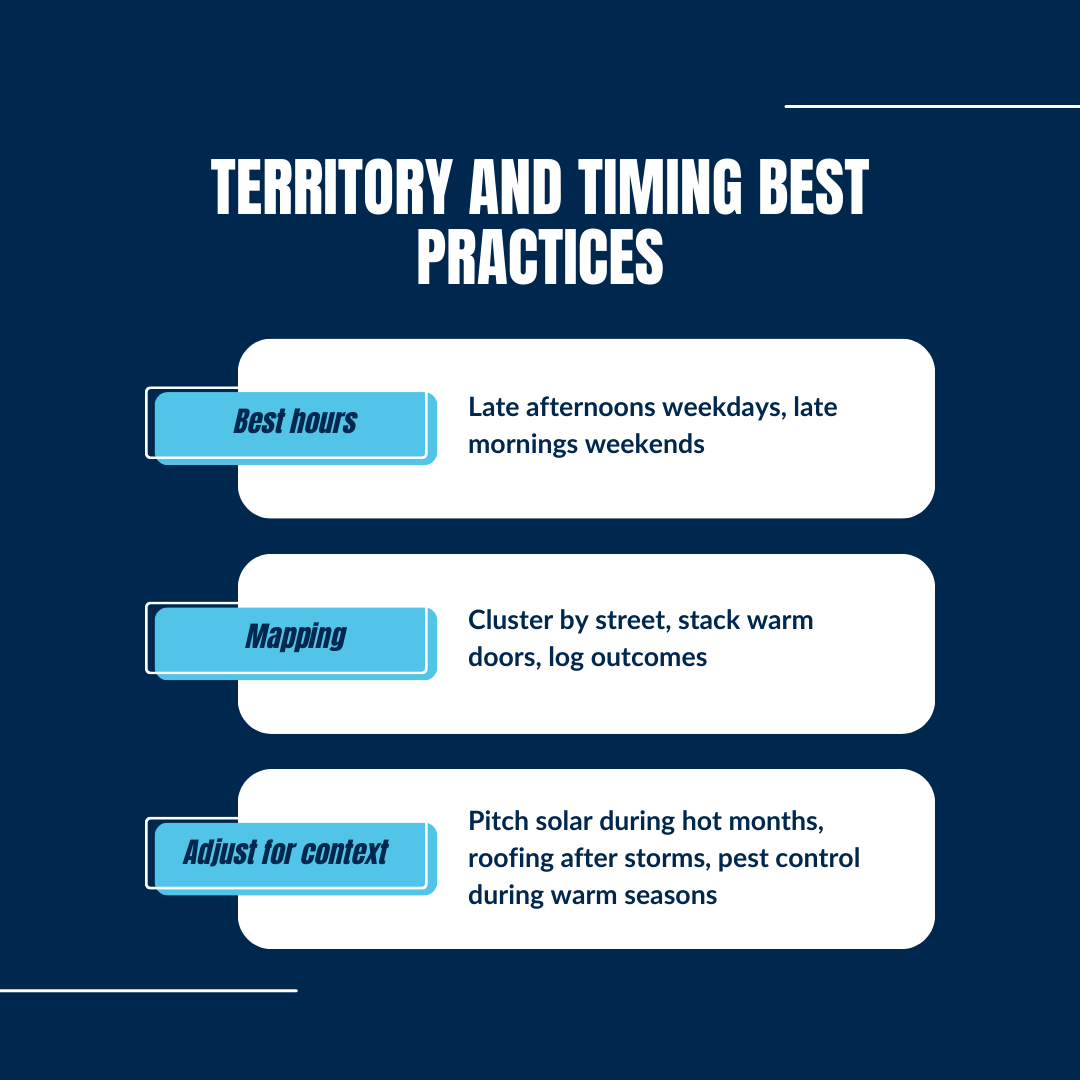
Best hours: Late afternoons weekdays, late mornings weekends
The sweet spot for door-to-door sales is when people are most likely home but not too busy. Late afternoons on weekdays and late mornings on weekends typically offer the best opportunity to connect.
Mapping: Cluster by street, stack warm doors, log outcomes
Work smarter, not harder. Group homes by street, revisit doors where interest was shown, and always log what happened so you can build momentum instead of starting fresh every time.
Adjust for context: Pitch solar during hot months, roofing after storms, pest control during warm seasons
Matching the timing of your pitch with what’s top of mind makes all the difference. Whether it’s high bills in summer or roof damage after a storm, align your offer with their current pain point.
The average conversion rate for door-to-door sales ranges between 2% to 3%, with skilled sales reps achieving higher rates through refined scripts and personalization.
What to Carry in Your Prep Kit
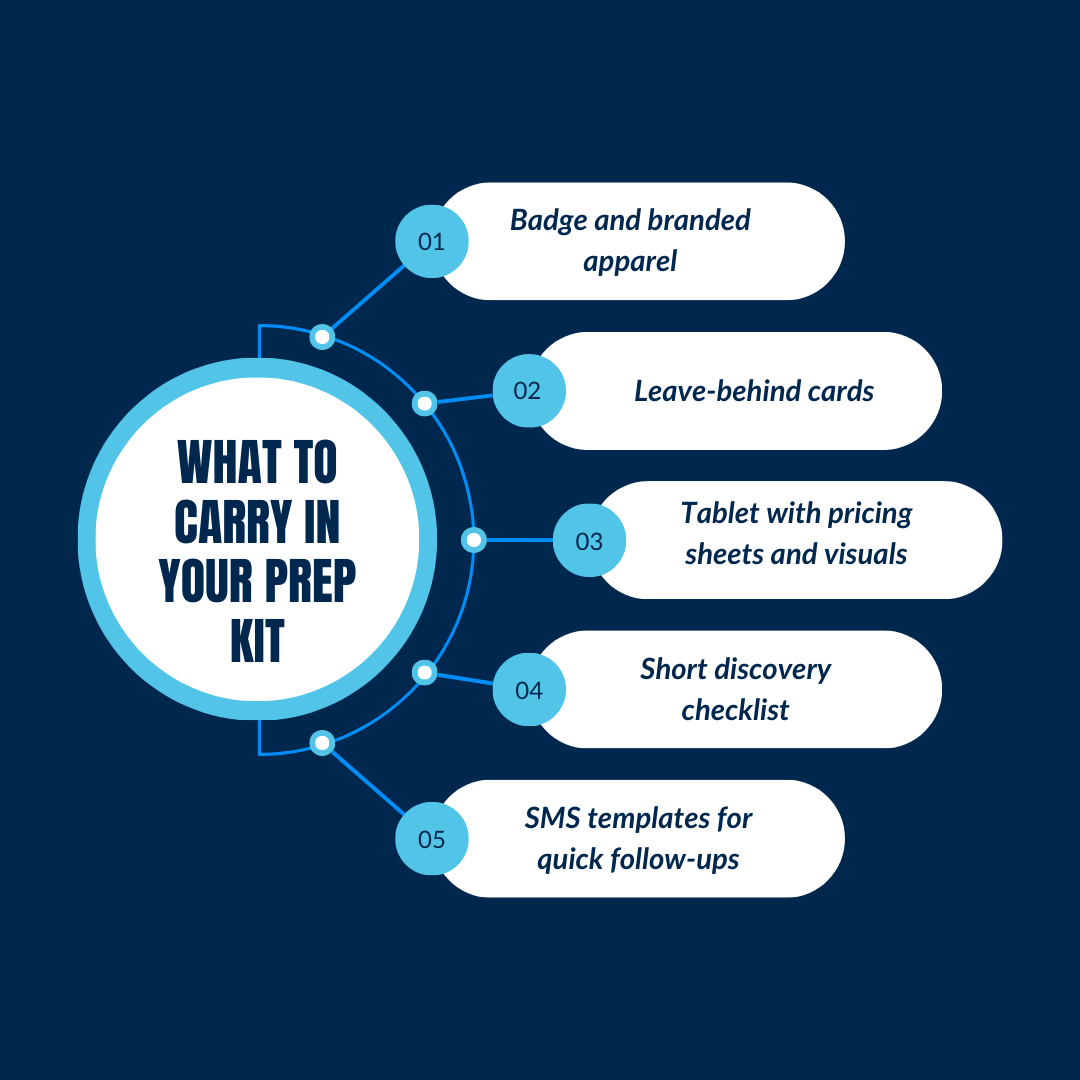
- Badge and branded apparel
Looking professional matters. A visible badge and company-branded clothing instantly build trust at the door. - Leave-behind cards
Not everyone says yes right away, so always carry simple cards that remind them who you are and how to reach you. - Tablet with pricing sheets and visuals
A tablet makes your pitch easier to show transparent pricing, photos, or quick demos that make your offer feel real. - Short discovery checklist
Keep a simple checklist handy to note needs, timelines, and objections so you never miss key details during conversations. - SMS templates for quick follow-ups
Speed matters in canvassing. Having ready-to-send text templates lets you follow up while the chat is still fresh.
Knockbase is the solution to all your door-knocking needs. This guide provides answers to all your questions. Dive into this: Knockbase Review: Beyond Just Door-to-Door Tracking
Practice and Coaching for Better Door-to-Door Sales
Even the best sales script won’t work without training.
- Role-play openers and objection drills
Running role-plays with your team helps sharpen openers and practice handling objections, so reps feel confident at the door.
- Record and review tonality
Listening back to your pitch recordings allows you to adjust your tone, pacing, and delivery to sound more natural and persuasive.
- Add personal twists to templates
Scripts are a guide, not a cage. Encourage reps to tailor their approach so every pitch feels authentic.
- Use sales enablement tools to track and log sales performance
Tracking performance with sales software shows what’s working and where reps need coaching to improve.
Consistent practice and coaching ensure your door-to-door sales scripts don’t just stay on paper but actually turn into results.
Performance Tracking and Optimization
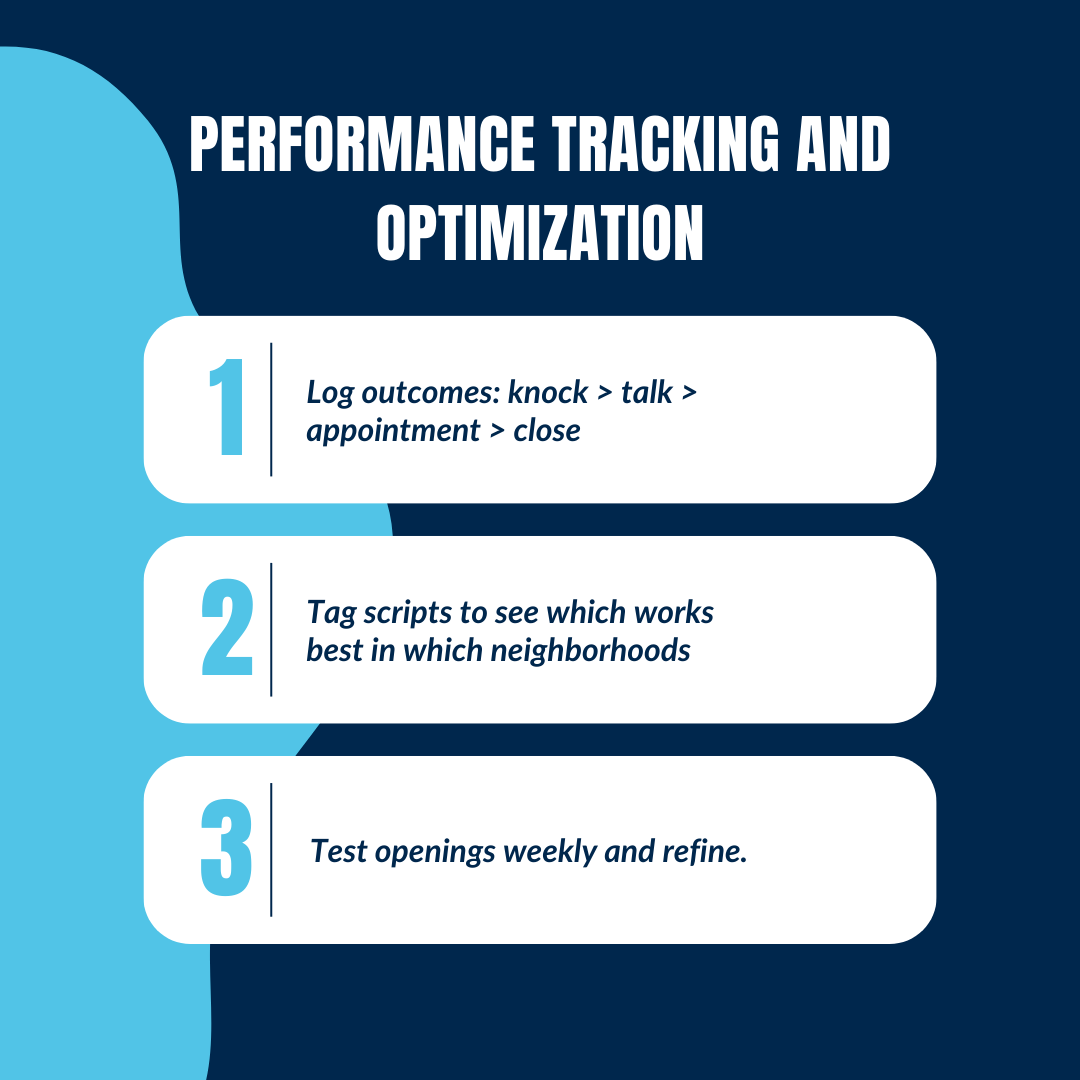
Don’t just knock, track.
- Log outcomes: knock > talk > appointment > close: Keep a simple record of every step, from the initial contact to the final close, so you can identify where deals stall and address the issues.
- Tag scripts to see which works best in which neighborhoods: Not every pitch works everywhere. Therefore, tracking which door-knocking scripts are most effective in certain areas helps you tailor your approach.
- Test openings weekly and refine: Minor tweaks each week, like adjusting your opener, can reveal what grabs attention and drives more appointments.
Tracking and refining your sales scripts is what separates average canvassers from future sales leaders.
Compliance and Respect
- Respect no-soliciting signs
Skipping homes with clear “no-soliciting” notices shows professionalism and keeps your canvassing strategy respectful. - Be transparent about data handling.
If you’re collecting names, numbers, or energy bills, explain how the info is used. Trust builds faster when you’re upfront. - Prioritize safety and professionalism.
From appearance to body language, maintaining a professional demeanor ensures homeowners feel comfortable and open to your pitch.
The best door-to-door salespeople understand that even if they don’t close a sale, leaving behind a positive impression can lead to referrals or future opportunities.
How Knockbase Helps You Reach the Right Customers
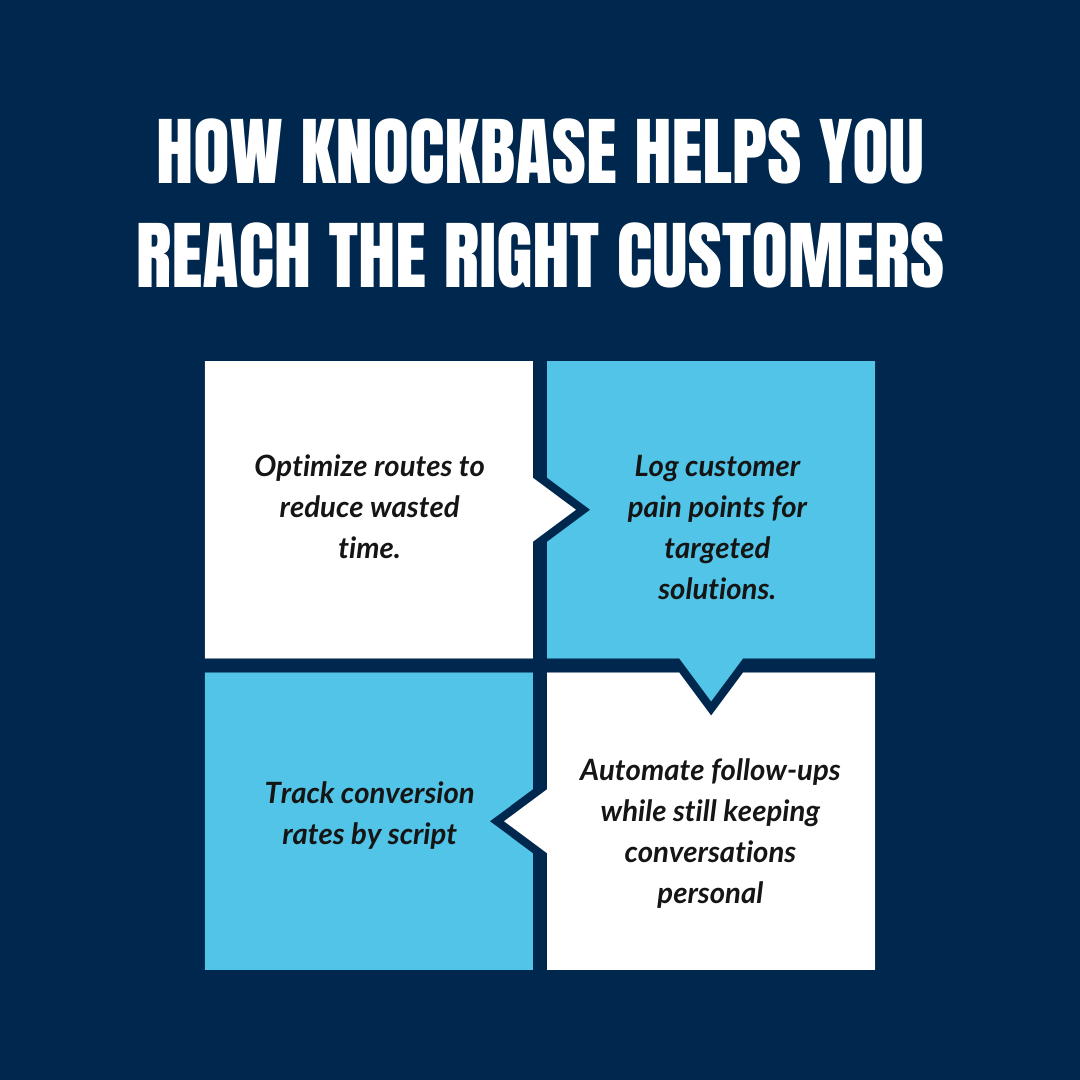
With a CRM like Knockbase, sales reps can:
1. Optimize routes to reduce wasted time
Knockbase helps sales reps plan smarter canvassing routes so they spend less time walking around and more time talking to the right customers.
2. Log customer pain points for targeted solutions.
Instead of guessing, reps can record what homeowners care about most and use those notes to deliver tailored pitches that actually stick.
3. Track conversion rates by script
Not sure which door-knocking script works best? Knockbase tracks results so reps can double down on the openings and closers that bring in more appointments.
4. Automate follow-ups while still keeping conversations personal
With built-in SMS and reminders, sales reps can follow up instantly in a way that feels personal and keeps the momentum alive.
5. AI-powered conversation tips
Get real-time suggestions on what to say next based on past successful pitches. It’s like having a personal sales coach in your pocket.
6. Geo-tagged activity tracking
Every visit is logged automatically with time and location stamps, so managers can see coverage accuracy and ensure transparency without micromanaging.
That’s how sales enablement tools like Knockbase turn everyday canvassing into a focused, data-driven strategy that brings in more sales and happier customers.
Conclusion
The best door-to-door script isn’t about clever words. It’s about connecting, listening, and delivering the best sales pitches while making it easy for prospects to take the next step. Scripts are starting points, and delivery, empathy, and professionalism are the key elements that seal the deal.
To sum up:
- Keep openers short and relevant.
- Listen carefully with open-ended questions.
- Handle objections calmly.
- Always leave the door open for the next step.
Whether you’re pitching solar panels, roofing, or advanced home security systems, the same principles apply. Respect their time, focus on the immediate benefits for a qualified prospect, and keep your sales pitch conversational.
Happy selling, and here’s to more doors opened, more conversations started, and a few tips to ensure more satisfied customers in 2025.
Close Smarter, Not Harder with Knockbase
See how Knockbase can double your canvassing results. With smarter targeting, real-time tracking, and built-in insights, your team spends less time guessing and more time connecting with the right customers. The result? More doors opened, more trust built, and more sales made, without working twice as hard.
Book a demo today and see how Knockbase can transform your canvassing into consistent business growth.
FAQs:
1. Why do door-knocking sales scripts still work in 2025?
Despite the growth of digital marketing, door-to-door sales continue to thrive because face-to-face interaction fosters trust, facilitates personalized conversations, and generates immediate feedback that sharpens the sales approach.
2. How should I handle objections when door-knocking?
Effective objection handling involves empathy, quick reframing to highlight benefits, and offering simple next steps, such as leaving information or scheduling a brief follow-up visit.
3. What are the best times to do door-to-door sales?
Research shows late afternoons on weekdays and late mornings on weekends usually yield the highest engagement and conversion rates, aligning with homeowners' availability and routines.






